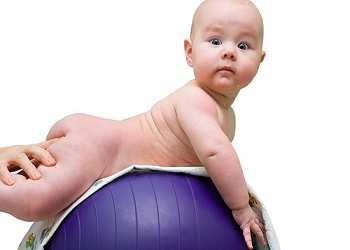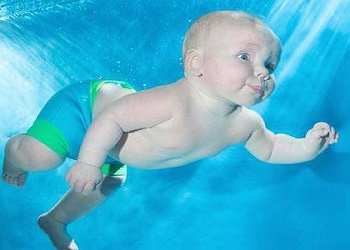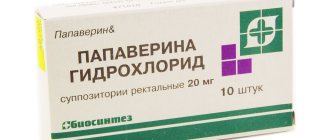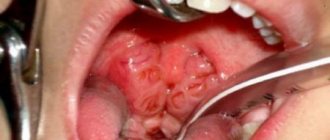Features of muscle hypotonicity
In the mother's belly, the baby assumes a fetal position. In this case, the limbs are in a bent position, the fingers are clenched into a fist. After birth, muscle hypertonicity is observed for several months. But the arms and legs can be easily straightened and the fists unclenched.
Hypotonia in infants is manifested by a weakened muscle state. Most often, the diagnosis is made after the muscles do not respond to stimulation or exposure to foreign objects.
The pediatrician should bend the baby's arm. If he has healthy muscle tone, then in response he will straighten it and take a position that is comfortable for him. If there is a disease, the reaction does not occur at all or after a certain period of time. This is due to the inability of the muscles to function properly.
Lethargy and weak muscle tone are the first signs of pathology
Signs of hypotonia in an infant are expressed by insufficient tension in muscle tissue . He becomes lethargic, and his limbs are almost always straightened.
For a long time, you may experience a reluctance to move or roll over.
The main manifestation of the disease is lethargy. But in some cases it cannot be diagnosed immediately.
Parents may complain about problems with breastfeeding - the baby refuses to take the breast or sucks inactively.
Each feeding is difficult for him - weakened facial muscles make the sucking reflex difficult. He suffers from a lack of muscle tension, which prevents him from raising his head to a vertical position. It is difficult for a child to learn to crawl, walk or pick up objects.
When the baby begins to make his first attempts at walking, he instinctively uses his legs bent at the knees for balance. The sick child tries to place them as wide as possible. In addition, he may notice prolapse of the tongue, intermittent breathing, and a drooping lower jaw.
Diagnostics
The initial check for abnormalities in muscle tone is carried out by a local pediatrician. It includes:
- Stepping reflex - the child is raised to a position in which his feet touch a flat surface. When feeling support, a healthy baby takes small steps, and a sick child tries to sit down. The reflex is tested in babies at 2 months; later it disappears spontaneously.
- Transition to a sitting position - the child is lifted by the arms, at this moment he tenses his muscles and pulls himself up. The lifter feels as if the baby is pulling him in the opposite direction. If the muscles are weakened, the newborn hangs, sticking his stomach forward. The back becomes rounded, the head moves freely due to weak support from the neck muscles.
Important! Confirmation of the presumptive diagnosis is carried out by various specialists: a neurologist, an orthopedist, a cardiologist and a pediatric physiotherapist. A complete examination will help you choose treatment tactics.
Possible complications
Treatment of muscle hypotonicity in children cannot be delayed . Otherwise, serious consequences may arise. For example, its development after birth may be inhibited. He begins to hold his head up, crawl or sit later than his peers. The disease can lead to curvature of the spine or weakened posture.
Lack of treatment provokes weakening of the musculoskeletal system and the appearance of muscular dystrophy. Children who have recovered from hypotension subsequently exhibit excessive flexibility and plasticity.
Reasons for the development of hypotension in adults
The condition of decreased muscle tone in adults can be caused by:
- infectious diseases (meningitis, polio, encephalitis);
- non-infectious pathologies (spinal muscular atrophy, hiatal hernia);
- intoxication of the body (mercury, excess doses of vitamin preparations - hypervitaminosis).
- reaction to certain injectable drugs (in particular, a person’s individual reaction to a specific vaccine, against a specific virus or strain).
Treatment
Only highly qualified specialists can identify muscle hypotonia in newborns: a geneticist, a pediatrician, a neurologist, a cardiologist, an orthopedist, and a pediatric physiotherapist. An inexperienced doctor can only harm the baby’s health with prolonged and ineffective treatment.
Therapy for the disease consists of special gymnastics and massage. At first, the procedures should be carried out under the supervision of professionals, but after acquiring the necessary skills, parents can do this on their own.
In case of hypotension, the drug Elkar is prescribed, the use of which promotes the proper growth of the child’s muscle tissue and stabilizes the development of the nervous system.
Massage

Massage for hypotension should be carried out using high physical activity. This leads to stimulation of the skin and warming of muscle tissue.
In addition, the procedures have a beneficial effect on the functioning of all internal organs.
Massage movements of the limbs and the whole body have a positive effect on the nervous system. Depending on the child’s condition, he should be placed on his stomach or back. It is very important to ensure that all parts of the body are involved in the procedure.
The duration of one session is approximately ten minutes . If necessary, the attending physician may increase the time. Massage movements begin with the fingers, slowly moving to the surface of the back. In this case, it is necessary to apply light pressure on certain areas of the body in order to stimulate bioactive points.
During the session, the muscles are worked through rubbing, stroking, light pinching, and tapping. In the video you can see how to massage a child, including for neurological problems.
During the massage, it is necessary to monitor the baby's behavior. If he behaves restlessly, then the session should be rescheduled for another time. Some actions may make him uncomfortable. In this case, you should consult your doctor. He will be able to select other equally effective movements.
Physiotherapy
The famous doctor Evgeny Olegovich Komarovsky considers therapeutic exercises for hypotension in infants to be an effective method of treatment. In addition, water procedures have a beneficial effect on the work and strengthening of all muscle groups.

Water exercises must be mandatory, because... strengthens the chest muscles in the best possible way
They can be combined with contrast hardening. But the sessions must be strictly supervised by specialists. What water temperature should be when bathing a baby - read here.
Some gymnastic exercises for muscle hypotonia in an infant can be done independently:
- The baby is placed on its back. The arms are first moved apart, and then the right one is brought behind the left one and vice versa.
- In the same position, the child is taken by the upper limbs, slowly bent and straightened at the elbows.
- Taking the baby by the hands, you need to lift him to a sitting position. This exercise is done slowly and carefully so that the muscles have time to tense.
- The legs rotate gently, simulating riding a bicycle.
- The lower limbs need to be straightened and the “scissors” exercise should be done, slowly gaining amplitude.
In specialized institutions, a large rubber ball (fitball) is used during treatment, which has a beneficial effect on the muscles:
- The baby is placed on his back and, holding his tummy, makes jumping movements up and down.
- The child is placed in a prone position. The ball is gently rolled back and forth. The exercise is repeated until the baby begins to bend his legs when moving forward.
These exercises must be done daily in conjunction with massage. This will allow you to restore muscle tone in a short time - the legs and arms will become stronger, the child will begin to hold his head.
Not only massage and therapeutic exercises can improve the condition of a baby. In some cases, the doctor may recommend physiotherapeutic procedures and medication.
Water procedures, which should only be carried out by a highly qualified specialist, have a beneficial effect on strengthening muscle tissue. Walking in the fresh air is a must. When to start walking with a newborn in winter and what rules should be followed is the topic of this publication.
Symptoms
Muscle hypotonia is diagnosed fairly quickly due to its specific manifestation. Muscle hypotonia syndrome in a newborn and older infant is accompanied by pronounced symptoms:
- weakness and slow muscle response;
- weakening or complete absence of unconditioned reflexes: grasping or sucking;
- labored breathing;
- frequent finding of the child in positions not typical for infants;
- muscles feel soft and flabby;
- increased salivation;
- low mobility of facial muscles;
- frequent joint dislocations in childhood;
- lack of resistance during unnatural flexion of the knee or elbow joints.

In the absence of timely treatment, children suffering from muscle weakness begin to lag behind in development. They begin to sit up, crawl and walk on their own late. In some cases, there is a delay in speech development, which is caused not by a disruption in the functioning of the nervous system, but by weakness of the speech apparatus.
Muscle hypotension in adults is accompanied by the following symptoms:
- a feeling of weakness throughout the body that is not associated with physical fatigue;
- increased sweating;
- sudden headaches that do not go away after taking strong painkillers;
- spontaneous attacks of tachycardia;
- increased joint mobility;
- sleep disorders;
- lack of sensitivity in the limbs;
- pinching pain in the chest area.
The symptoms of decreased muscle tone in adults are not as clear as in childhood. This may make it difficult to detect pathology in a timely manner.
Prevention
Preventive measures for muscle hypotonicity in infants should begin during pregnancy planning . Parents need to eat a healthy and balanced diet, avoid alcoholic beverages and nicotine. An important role during this period is played by a complete examination, which is aimed at identifying genetic and infectious diseases.
A pregnant woman is recommended to spend a lot of time outdoors, regularly visit a gynecologist, and undergo examinations. By ensuring the normal development of the fetus, many serious diseases can be avoided.
After birth, the baby needs periodic comprehensive medical examinations and consultation with a local pediatrician for the slightest changes in behavior. Daily exercise and swimming will help maintain your baby’s health and strengthen muscles.
To prevent the appearance of hypotension in a child, he needs to develop fine motor skills. This will not only concentrate the baby’s attention, but also strengthen the muscle tissue of the limbs. For classes, you can use mosaics, plasticine, and various educational games with your fingers.
Particular attention should be paid to the baby's nutrition . When compiling a daily menu, the attending physician must take into account the characteristics of the sick child. After all, with food he receives most of the nutrients and vitamins that are necessary for proper growth and development.
What is this violation?
Muscle hypotonicity is a special condition in which the tone of certain muscle groups decreases.
Very often it is closely related to the development of paresis (decreased muscle strength). Muscle hypotonia may indicate the progression of diseases that result from damage to motor neurons. Many medical experts believe that this pathology should be classified as a non-standard muscle disorder.
The disease was first identified, studied and described in detail in 1900 by Oppenheim. At that time, the disease was called Oppenheim's myotonia.
But, since muscle hypotonicity in most cases becomes a consequence of other diseases, already in 1918 it was decided to call this condition of the body “flaccid child syndrome.”
Today, most experts identify muscle hypotension syndrome as a separate diagnosis, since it combines all variants of the disorder, regardless of the factors that could provoke its development.










